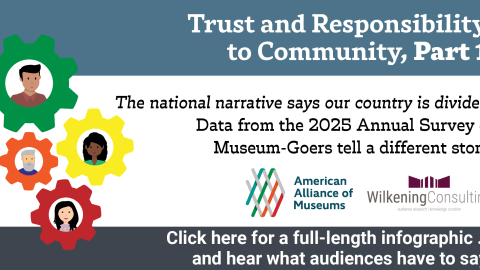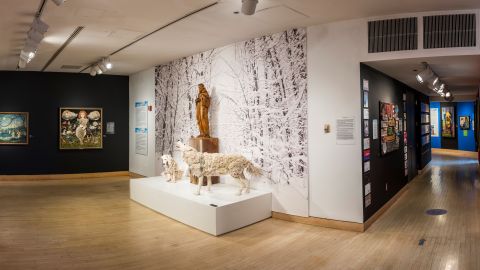Museum practitioners are energized, perturbed, or both by the prospect of a future in which people spend more and more of their time immersed in virtual worlds. After all, the virtual is the enemy of the real, right? Some counter that a society where people spend more of their work and leisure time in virtual worlds will cause a backlash of people valuing museums more than ever, as engaging physical environments and purveyors of access to the “real thing.”
The relatively few museums that are dabbling in immersive, 3-D virtual worlds often use them to supplement their existing physical space, either to provide access to people who can’t visit, or different kinds of experiences, or access to information not available at the museum itself. The Tech Museum of Innovation uses its Second Life space—the Tech Virtual Museum Workshop to encourage innovative exhibit design that may then translate into physical exhibits. (Of course, they are the museum you would hope is pioneering virtual space.) A few, like the Smithsonian Latino Virtual Museum, exist only on-line.
Museums often lag behind the technological bandwagon, though. You’ve heard of early adopters? Museums tend to be the opposite, riding the lag end of the curve. A decade ago this was a problem for many small museums struggling to establish web sites with limited expertise and technological resources. (Though this gap is shrinking: a 2004 study by the Institute of Museum and Library Services reports that 88 percent of museums had a Web site as of five years ago—doubtless the figures are even better now.) To the extent that virtual worlds prove useful (maybe even necessary) to museums, it is disturbing to think that we might again lag behind the tech curve, and possibly create a cadre of technological haves and have-nots within the museum field.
So, I am particularly happy to report on an initiative that may help reduce the risk of such technological disparities. The Virtual Immersive Technologies and Arts for Learning Laboratory (VITAL Lab) at Ohio University is working on a project they call iVirtualWorld. This is a kind of automated Virtual Museum Builder—a turnkey program to help museums generate 3-D, navigable virtual museums populated with digital assets (images of collections objects, audio, movie files, even 3-D digital models.) Such an application would simplify the creation of a virtual site the way that PowerPoint simplified the creation of digital slide presentations, or a site like Blogger, WordPress or Livejournal simplified creation of a blog. Offering a choice of various virtual formats, such as Second Life, Unity3D or OpenSim, it will enable a user to chose the size, style and configuration of their virtual museum, upload content and automatically generate their museum. iVirtualWorld is a university research project and the intent is to make the final product available free to users.
Chang Liu, VITAL Lab director, is looking for a museum partner to work with the VITAL Lab, testing out iVirtualWorld’s museum-building capabilities. The prospective partner would provide engaging subject matter and content, digital assets (existing or planned) and narratives. And Chang notes, most importantly, imagination! No financial contribution from the museum is expected. If your institution is interested in signing on as a partner to test iVirtualWorld’s museum-generation tools, contact Chang Liu at liuc@ohio.edu. <
And I would like to hear from you–if you did build a virtual museum, what would be your goal? Would it mimic your existing institution, or would it be a platform to try things that are physically or financially impossibile in the real world?









Hi! In my very personal opinion,
one important function of Art and
Culture, in general, consists
precisely in being visionary:
opening minds and showing new
possible ways. It is very important
in a constantly changing world to
help people facing the new and the
unknown without fear – respecting,
of course, ethical principles!
DinisKlopries
Any museum interested in partnering with a university lab or external entity to design and disseminate their content in a virtual world environment for example, should conduct smart practices in researching the best resources available such as independent artists working on the grid to ensure cost efficiency, cultural sensitivity and a strong skill set in interdisciplinary collaborative work processes. Museum best practices differ from the academic realm and this fact should be taken into account when selecting a collaborating organization in order to prevent miscommunication and potential conflicts that will negatively impact the production of a virtual museum.
If you would like more information about our lessons learned in building a virtual museum in Second Life, please contact me: Melissa Carrillo (carrillom@si.edu), Smithsonian Institution.
Wow! I was so psyched when I saw the title. But then as I read…well..
Cross-platform distribution between grids already exists and is being done by several entities. Because of this, assets and components can be packaged and boxed, which then can be dropped into all the immersive environment applications you listed and rezzed for instant access. This is not something new, people are doing it already. Templates are already in existence that anyone in industry can put components into and create a virtual immersive environment.
I also find it strange that there is really no information about this initiative on your own website.
Forgive me,and I really love this blog itself, but this posting sounds like someone is pulling the ole tech wool over eyes in fishing for a possible grant partner for future funding.
There really is too much of this going on with new technologies. My advice is for everyone out there to do their own research before jumping on board with any new tech claim.
Dean–I am glad you enjoy the blog! Please do share more information with our readers. Perhaps you can list some of the other groups working on projects like this, for museums that are interesting in becoming virtual pioneers? For the majority of museums (and their staff) this is such foreign territory they would not know where to begin. That is part of what makes the prospect of a "turnkey" solution aimed specifically at museums so intriguing.
There is no information on this project on the CFM website because it is not a CFM initiative. I love to pass along news about opportunities for museums to partner with other groups on innovative practices, particularly when the group is an academic or other non-profit. (I am cautious about the slippery slope of promoting initiatives by for-profit entities, however well-intentioned.)
Most of projects that aim to benefit museums that will not be supported by a commercial model (i.e., not being developed for sale by a for profit firm) will probably need grant funding for development and distribution. I hope intelligent museum partners can help ensure these experiments are well-conducted, realistic and meet the needs of the field.
Elizabeth Merritt
Google's Sketchup tool is a perfect example of a "Turnkey" solution for 3D content. It allows you to create, modify and share 3D models.
Again, there is alot out there and I agree with Dean's and Elizabeth's posts…and reiterate my own point of cautioning museums to do their homework first before partherning with anyone.
Our lessons learned include making sure our collaborative design teams understand what it means not just how to distribute the content…but the interdisciplinary process involved in creating the cultural contexts and experiences that are crucial to the dissemination of information. So many entities out there are less interested in the 'meaning making' and more interested in their own 'name making'and maintaining overhead costs.
It is a new frontier…and museums are barely understanding the possibilites of immersive learning approaches via virtual worlds.
Brave New World indeed…Explore!